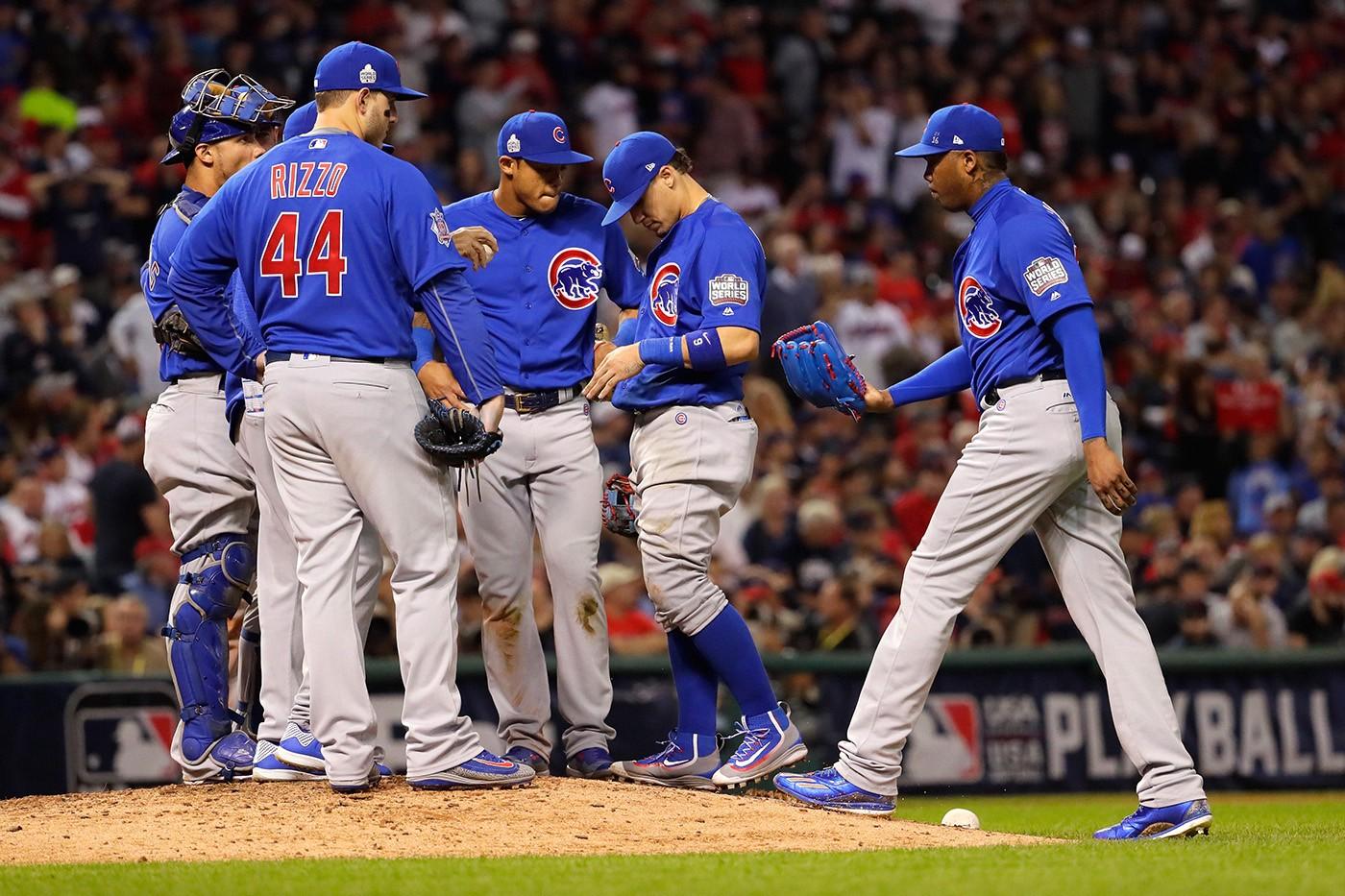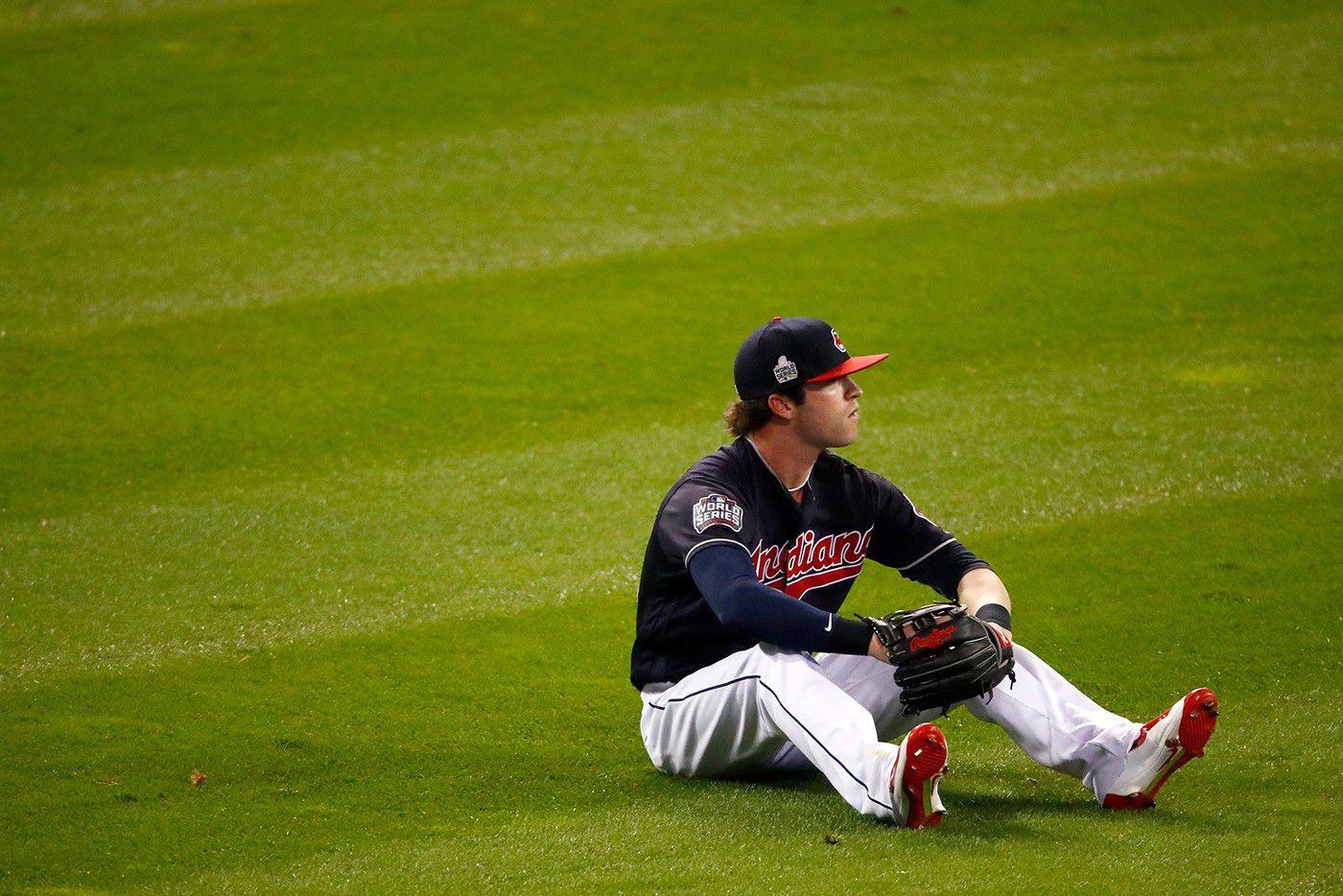
Considering that Game 6 was over by the fourth inning, no one’s going to remember how close Josh Tomlin came to getting out of the first unscathed.
Tomlin, usually a no. 5 starter who’s reinvented himself as a curveball specialist to great success this postseason, retired Dexter Fowler and Kyle Schwarber quickly, then put two quick strikes on Kris Bryant. Bryant, like most hitters, is dreadful on 0–2 pitches: .185/.211/.294 for his career. But Tomlin hung a curveball down and on the inside part of the plate, a part of the zone where he has a career .828 slugging percentage. Bryant hit the ball 433 feet.
If Tomlin buries that curveball and gets it past Bryant, the inning is over and maybe Chicago doesn’t end up winning 9–3. Maybe there’s nobody on base when Addison Russell pops up to medium right-center, which is where everything went wrong, as center fielder Tyler Naquin and right fielder Lonnie Chisenhall converged on the ball, it fell between them and allowed two more Cubs to score.
Even in as low-scoring and hyperfocused a postseason as this, a 1–0 lead is nothing, particularly over the course of nine innings. A 3–0 lead, however, is a firm shot in the jaw, and when that fly ball dropped into center it kicked off a career night for the 22-year-old Russell and a waking nightmare for the 25-year-old Naquin.
Russell’s double — as it was scored, since nobody touched it — visibly shook Naquin, who used both arms to wave off Chisenhall on a fly ball later that inning, then hit the deck on another fly ball to right center, which Chisenhall caught. And when Russell came up again in the third, he hit a grand slam that all but knocked the Indians out. The first-ever grand slam by a shortstop in the World Series gave Russell six RBIs on the night, tying the single-game World Series record.
But it wasn’t completely over until the fourth. Jason Kipnis, who went 3-for-5 with a home run and scored Cleveland’s first two runs, sparked a rally that resulted in Arrieta, who was struggling to command the ball, facing Naquin with the bases loaded and two out in a 7–1 game. If Naquin hadn’t walked under a ladder before the game, maybe we would talk about how a called strike one on a pitch several inches off the plate changed the direction of that at-bat, but Naquin really never stood a chance, and he struck out on four pitches without seeing anything off-speed.
Then it all became about Game 7.

From the fourth inning on, Indians manager Terry Francona was setting his team up for Game 7, rather than selling out for a comeback at all costs. That was the percentage play; the last moment the Indians had greater than a 10 percent win expectancy was the at-bat before Russell’s grand slam. Francona kept all his big bats in the lineup in case they popped off for a crooked number out of nowhere, but of his four best relief pitchers, the only one who saw action was Dan Otero, who entered the game while it was still 3–0, allowed Russell’s grand slam, and threw only 11 pitches anyway. In an ideal world, maybe Danny Salazar wouldn’t have pitched two innings, but if his services were necessary in Game 7 with Corey Kluber starting and Andrew Miller and Cody Allen both on at least two days’ rest, it would mean that Francona and the Indians would have bigger problems.
In Game 6, Francona put the Fabian strategy at work in baseball terms, as he conserved his best pitchers to better prepare the Indians for a climactic confrontation he had a better chance at winning. With Kluber on the mound, Miller on three days’ rest, and Allen and Bryan Shaw both on two days’ rest, the Indians’ bullpen could not be better positioned for Game 7.
Maddon, however, was fighting for his team’s life, and he brought in Aroldis Chapman — one day off a 42-pitch, eight-out save — for four more outs and 20 more pitches with a five-run lead in Game 6. At first glance, bringing in a closer who’s been worked heavily over the past week with a big cushion in the seventh (a leverage index of only 0.61, as opposed to 2.46 when he appeared in Game 5), a day before the team’s most important game since 1945, seems like overkill, and it might be. But with only one game left in the season, and with so much at stake, generalized statistics like leverage index don’t tell the whole story.
By bringing in Chapman for 20 pitches, Maddon increased his chance of winning, compared to staying with Mike Montgomery or bringing in a different reliever. With a lead that large, it’s overwhelmingly likely that Pedro Strop or Justin Grimm or Travis Wood would have held the lead anyway, but if they don’t, the season’s over and the Cubs flip the Years Since Last Title sign over to 109.
One reason closers don’t pitch more innings is that they’ll get hurt from overuse. This isn’t the issue with Chapman, who’ll be a free agent after the season and has one game, and one game only, left to pitch for the Cubs. Callous as that might sound, Maddon and the front office are completely unconcerned with wearing out Chapman’s shoulder or elbow since his health won’t be their problem by this time on Thursday. The two risks to using him in Game 6 are (1) freak injury, as we nearly saw when he came up hobbling after retiring Francisco Lindor at first on a 3–1 ground ball and (2) fatigue.
Now, fatigue is the only concern. Remember how Kenley Jansen looked when Dave Roberts finally took him out in Game 5 of the NLDS in Washington, throwing balls on eight of his last 10 pitches? That’s the nightmare scenario — not that Chapman walks off holding his elbow, but that after 62 pitches in three days, he won’t be able to make it through a two-inning stint in Game 7 without getting too tired to throw strikes by the end.
So Maddon’s mental calculation was this: Is the risk of losing a five-run lead in Game 6 with Pedro Strop’s Flying Circus greater than the risk of wearing Chapman out? I don’t know. Maddon and pitching coach Chris Bosio have a better idea than we do, but they don’t know for certain, and I bet that if he were being completely honest, Chapman himself doesn’t know where his limit is either.
While Francona had the luxury of living to fight another day, Maddon had to manage like tomorrow would come only if the Cubs won. Well, he did, and the Cubs won, and now tomorrow’s on its way, bringing with it unknown consequences that will shape baseball history forever.